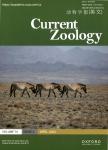Happy together? Avoidance of conspecifics by gregarious mussels
Happy together? Avoidance of conspecifics by gregarious mussels作者机构:Faculty of Biology and Environmental Protection Department of Invertebrate Zoology Nicolaus CopernicusUniversity Lwowska 1 Torun 87-100 Poland
出 版 物:《Current Zoology》 (动物学报(英文版))
年 卷 期:2018年第64卷第1期
页 面:53-61页
核心收录:
学科分类:0710[理学-生物学] 07[理学] 0905[农学-畜牧学] 09[农学] 0906[农学-兽医学] 071002[理学-动物学]
基 金:supported by internal funds from N. Copernicus University in Torun Poland
主 题:回避反应 贻贝 基础类型 群居 环境影响 高密度 晶簇 北美洲
摘 要:Zebra mussel is a Ponto-Caspian species invasive in Europe and North America, with great environmental impact. It lives byssally attached to hard substrata in large aggregations, which is often explained by its preferences for conspecifics, though direct evidence for such preferences has been rather limited so far. We studied the reactions of zebra mussels to conspecifics, hypothesizing that they may either be attracted to one another or form aggregations only in the absence of alternative attachment sites. In Experiment 1, we tested mussel tendency to detach from existing druses depending on druse size (2-25 individuals) and substratum type (soft: sand; hard: glass). Mussels detached significantly more often on the hard substratum and from larger druses compared to soft substratum and smaller druses, respectively. This indicates that mussels tended to avoid conspecifics at high density, particularly when alternative substratum was available. In Experiment 2, we tested the responses of single mussels to distant (3 or 15 cm) conspecifics (0, 3, 15 individuals per 2.5 l tank) on the sandy substratum. The presence of conspecifics, regardless of their distance and density, resulted in single unattached mussels staying more often in their initial positions. Mussels did not move preferentially towards or away from the conspecifics. Thus, even on unsuitable substratum mussels were not attracted by conspecifics and probably exhibited an avoidance reaction by reducing their movement. This suggests that dense mussel aggregations are formed due to the lack of available alternative attachment sites rather than due to their preferences for conspecifics.



